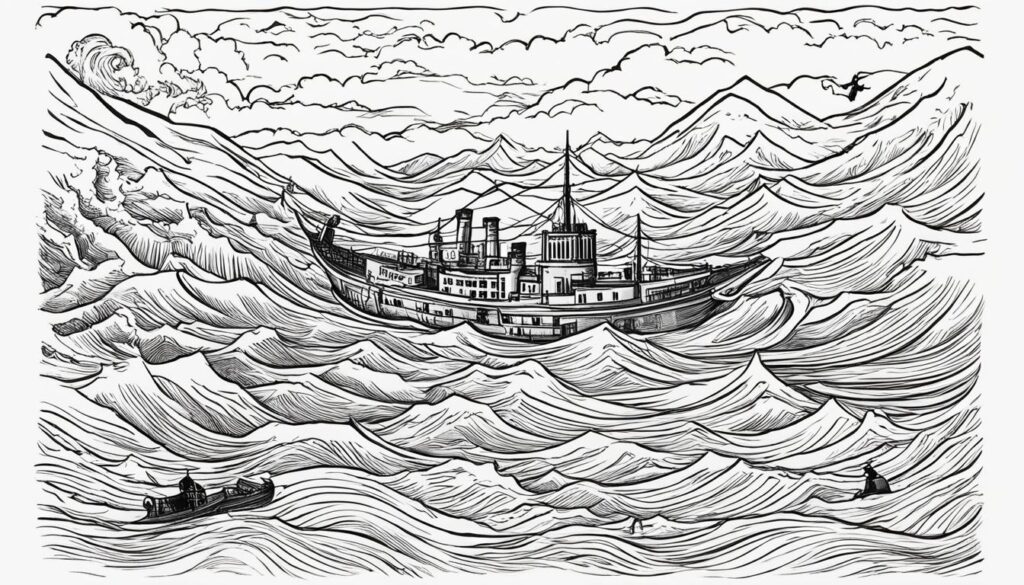Immerse yourself in a gripping tale where history meets horror. This audiobook review delves into “The Terror” by Dan Simmons, a work that masterfully intertwines the thrill of historical fiction with the bone-chilling elements of horror. Join the harrowing journey of a crew set against the unforgiving backdrop of the Arctic, a setting brought to life through an audio experience that promises to leave listeners haunted long after the story concludes. Dan Simmons, known for his ability to craft detailed, suspenseful worlds, does not disappoint. Here, we explore the eerie reality and the fictitious horrors that blend seamlessly in this chilling narrative, setting a new precedent for historical fiction horror.
As we venture into the heart of this audiobook review, we are confronted with the stark terror that accompanies the crew of a legendary historical expedition. “The Terror” offers a disturbing odyssey that captures the imagination and plays on our deepest fears, introducing us to a dimension of horror that extends beyond the pages of a novel, into the very souls of its listeners.
Introduction to “The Terror” and Its Historical Backdrop
The unnerving narrative of Dan Simmons’s “The Terror” unfolds against the chilling backdrop of one of the most enigmatic naval mysteries in maritime history—the ill-fated Franklin Expedition. In 1845, under the command of Sir John Franklin, the HMS Terror and its companion ship, HMS Erebus, embarked on a bold venture into uncharted waters, aiming to locate the Northwest Passage—a fabled sea route across the Arctic. The tragic fate of the expedition, which left no survivors, has sparked intrigue and speculation for over a century, securing its place as one of the greatest historical mysteries of Arctic exploration.
This dramatic true-life adventure is reimagined with a blend of historically accurate details and a menacing supernatural twist. At the heart of Simmons’s horror retelling are the crew members of the HMS Terror, who find themselves in a harrowing struggle for survival against the ruthless Arctic elements and an unseen terror that stalks them across the frozen landscape. The novel’s infusion of factual events with imaginative fiction serves to amplify the intense atmosphere of desolation and dread that pervades the story.
Simmons’s attention to historical detail immerses readers in the harrowing experiences of the Franklin Expedition’s crew. Their encounters with the relentless Arctic environment are portrayed with an authenticity that pays homage to the courage and determination that marked this bold bout of Antarctic exploration. The atmospheric setting of the novel thus reflects the profound spectral quality of the expedition’s silent legacy, with the icy expanse of the Arctic serving as a hauntingly vivid character in its own right.
Simmons weaves a fiction that extends beyond the boundaries of history, utilizing the unknown elements of the Franklin Expedition’s narrative to craft a tale filled with suspense. As the men of the HMS Terror confront the relentless pressure of their circumstances, the historical mystery augments the story’s fictional elements, resulting in a narrative experience that is profoundly unsettling, not merely for the grisly fates it portrays but also for the larger questions it posits about humanity’s place in the indifferent vastness of nature.
Author Dan Simmons: Master of Horror and Historical Fiction
Exploring the works of Dan Simmons reveals a confluence of deep historical knowledge and a talent for spine-chilling narratives. As a horror fiction author, Simmons stands apart for his ability to infuse his passion for historical literary works into the genre, creating stories that linger in the reader’s mind long after the last page. His literary career has been marked by a series of successes that showcase his versatility and depth.
A Glimpse into Dan Simmons’s Literary Career
Dan Simmons has crafted a career that many aspiring authors dream of. With a start in the horror genre, he quickly expanded his repertoire to include science fiction, fantasy, and historical fiction. However, it is his profound blend of horror with historical intrigue that has cemented his reputation. Titles such as “Drood” and “The Terror” demonstrate Simmons’s skillful narrative construction, weaving meticulously researched historical detail with his vivid imagination.
Connecting Historical Facts with Fiction in Simmons’s Works
The hallmark of Dan Simmons’s writing is his seamless integration of historical events and figures with fictional elements. His ability to bring the past to life while introducing horror elements has allowed him to pen narratives that are as educational as they are entertaining. The intensity of his storytelling is exemplified in works like “The Terror,” where the true story of the Franklin Expedition is transformed through Simmons’s unparalleled world-building into a chilling tale of survival and dread.
Both critics and fans alike have recognized Simmons for not just the quantity but the quality of his work. Whether it’s through eerie tales of the supernatural or poignant historical narratives, Dan Simmons continues to prove that his pen is as sharp as ever, leaving an indelible mark on the world of literature. His ability to create tension-driven plots that not only entertain but also provoke thought is what makes him stand out as a master of both horror and historical fiction.
“The Terror” Synopsis: A Journey into the Unknown
Amidst the unforgiving ice and the cold whisper of the Arctic, “The Terror” unfurls a story that melds supernatural horror with the gritty reality of Arctic survival. This expedition novel revives the haunting history of the Franklin Expedition with a twist of horror that rises from the frozen landscape, turning an already harrowing tale of exploration into a chilling tale that lingers long after the last page is turned.
As the characters navigate a frightening odyssey, fighting against the forces of nature and an unseen terror, Dan Simmons artfully uses the crushing ice and ceaseless cold to craft a backdrop that is as much a character as the men aboard the HMS Terror themselves. It is not merely a story of survival, but one that questions the limits of the human spirit when faced with the supernatural.
Here, the Arctic does not forgive, and the shadowy depths harbor more than just secrets. It’s a perilous realm where the battle for survival becomes as much internal as it is external.
Simmons’s narrative deftly examines the intricate web of relationships among the crew, the strain of command, and the creeping dread of the unknown. With the environment as a catalyst, the novel takes readers on a jarring psychological journey manifesting in an oppressive atmosphere, teeming with suspense.
Without divulging the core mysteries Simmons so skillfully embeds within the twisting plot, the synopsis stands as an invitation—an invitation to witness a journey shrouded in darkness, where the supernatural emerges as both a terror and a tantalizing enigma. As the men of the Franklin Expedition traverse beyond the brink of the known world, they—and the readers—are left to grapple with questions that challenge their understanding of nature, the supernatural, and the sheer will to endure. Will you brave the cold and journey into the unknown?
Character Analysis: The Men of the Franklin Expedition
In Dan Simmons’s gripping novel, “The Terror”, the fictionalized account of the historical Franklin Expedition becomes a canvas for intricate character development. The expedition crew not only battles the cold and unknown but also faces profound leadership challenges and the creeping dread of survival horror. By exploring their dynamics, we gain insights into what propels men to the brink of humanity when faced with the extreme.
Leadership Under Duress
Throughout the harrowing ordeal faced by the Franklin Expedition, the novel dissects the essence of leadership. It showcases how individuals respond to crisis, adapt to changing conditions, and make decisions that could mean life or death for themselves and others. Here, leadership is multifaceted — a force for unity, a source of conflict, and a crucible for character.
Survival Against All Odds
As the grim reality of an Arctic winter sets in, each character’s instinct for survival is laid bare, accentuating their depth. Amidst isolating darkness and sheer desperation, the crew’s determination and will to persevere are poignant observations of the human spirit when it’s pushed to its limits.
| Character | Role in Expedition | Leadership Qualities | Survival Tactics |
|---|---|---|---|
| Captain | Angular stone of hope and order | Decisive, steadfast, carrying the heavy mantle of command | Utilizing experience and naval strategy |
| Surgeon | Healer, confidant, moral compass | Compassionate, empathetic, a stabilizing force | Relying on medical knowledge and rationality |
| Crewman | The backbone of the expedition, executing orders | Resilient, adaptable, unwavering in the face of fear | Leveraging camaraderie and resourcefulness |
The men of the Franklin Expedition are not merely characters in a novel; they are poignant representations of human resilience and fallibility. In Dan Simmons’s “The Terror,” they are etched into our memories, not for the horrors they face but for how they confront their own inner darkness when the light of civilization grows dim.
The Myth and Mystery Surrounding the HMS Erebus and HMS Terror
The tale of the HMS Erebus and HMS Terror is deeply interwoven with the rich tapestry of maritime history. These legendary ships embarked on the perilous journey of polar exploration, voyaging into the icy embrace of the uncharted Arctic. Their fates would later stir the imagination and evoke the greatest nautical lore of the era, mysteries that Dan Simmons masterfully explores within his gripping narrative.
Built as bomb vessels and later repurposed for exploration, both the Erebus and Terror were equipped for the daunting environmental challenges of the polar regions. Their facades of strength became the literal vessels of Victorian ambition, seeking Northwest Passage amidst the frost and fog. The enigma of their disappearance fostered a mythic status, fueling stories and speculation that transcended the truths of their journey.
In The Terror, Simmons draws from these historical vessels and their shrouded legacy. He does not merely recount their history; he embroiders it with the supernatural, allowing fear and folklore to seep into the very planks and frames of the ships. Here, the Erebus and Terror are not mere settings, but pivotal characters that harbor the frozen echoes of their crews’ dread and despair.
The ships themselves become specters in Simmons’s retelling, harbingers of dread that sail through the narrative’s icy haunt.
The indelible allure of these maritime legends persists, as both a testament to human ambition and a cautionary tale of nature’s dominion. Within the annals of maritime history, the Erebus and Terror stand as monuments to the golden age of exploration—a time when the world’s edges were not merely maps to be filled, but mysteries to be unveiled, no matter the cost.
The Audiobook Experience: Narration and Atmosphere in “The Terror”
When venturing into the world of audiobook narration, few titles capture the essence of immersive listening like “The Terror”. The audio adaptation of Dan Simmons’s novel transforms the act of listening into a multisensory encounter, employing a blend of atmospheric storytelling techniques that push the boundaries of conventional audiobooks. In the sphere of horror fiction, the role of the narrator is elevated to transport the listener directly into the icy realms of the Arctic.

The auditory nuances of “The Terror” contribute significantly to its success as an auditory experience. The narrator’s voice must not only convey the narrative but also evoke the ominous atmosphere that permeates the novel. Sound effects and varying cadences work in harmony to construct an auditory landscape that is as stark and chilling as the Arctic itself. From the creaking of ship’s timbers to the howling Arctic winds, the soundscape of this audiobook narration generates an atmospheric storytelling environment that is hard to match.
The power of this audiobook lies not only in its well-crafted narration but also in its ability to forge a connection with the audience, making immersive listening a reality. The nuanced performance by the narrator guides listeners through the characters’ despair and determination, creating a palpable tension that lingers long after the story ends.
“The Terror” stands as a paragon of how expertly executed audiobook narration can set a new benchmark for immersive listening. The interplay of voice and sound turns an ordinary listening session into a riveting, atmospheric adventure, making it a golden standard in audio adaptations.
Comparatively, other horror audiobook adaptations may fall short in creating an equally immersive auditory space. The meticulous attention to the aural components of storytelling is what distinguishes “The Terror” and underscores the importance of audio in bringing a story to life. In sum, the audiobook adaptation of “The Terror” is a testament to how sound can be as haunting and effective as the written word in crafting unforgettable tales.
Understanding the Themes of Survival, Isolation, and Desperation
In “The Terror,” Dan Simmons skillfully paints a narrative saturated with thematic elements that resonate not just within the confines of the story but also within the human psyche. One can’t help but marvel at the portrayal of human endurance as the crew battles against nature’s ferocity, a narrative that is as much about the icy Arctic landscape as it is about the chilling journey into psychological horror.
Man Versus Nature: A Recurring Element
The omnipresence of a relentless environment is a narrative cornerstone, spotlighting the epic struggle of man versus nature. The novel embodies this conflict, plunging its characters into an abyss where survival hinges on their ability to overcome the extreme elements. In an unyielding arena of ice and desolation, the crew of The Terror faces the ultimate test of their resolve and resourcefulness.
The Psychological Strain of Isolation
As the overwhelming sense of isolation takes hold, Simmons dives deep into the psychological tremors that shake the human soul. The unending night of the Arctic winter, compounded by the absence of rescue, pits the crew not only against the external hazards but also against their own inner demons. The lingering dread of never being found, coupled with the fracturing of civilized conduct, fosters an environment where psychological horror thrives.
The audiobook’s intense atmosphere brings to life the visceral chill of isolation. With each spoken word, the audience is led further down a path shrouded in despair. The expert narration captures the essence of Simmons’ story, elevating the novel’s themes with each suspense-filled chapter, ensuring listeners remain riveted as the crew’s desperation reaches a fever pitch.
Dan Simmons’s Writing Style and Its Impact on the Storytelling
The cerebral spine of “The Terror” lies in the narrative techniques, descriptive writing, and the storytelling prowess of Dan Simmons. Through his meticulous crafting of scenes, Simmons engages readers with vivid descriptions that thrust them into the desolate and chilling landscapes of the Arctic. His writing demands imagining the desperate, maddened state of the Franklin Expedition’s crew as they navigate both tangible and unseen terrors.
Simmons uses a gripping pace, harmonious with the slow encroachment of ice and dread, to draw readers into a world where the environment is as much a character as the men aboard the HMS Terror. His use of descriptive writing does more than paint a picture; it creates an immersive atmosphere where the cold seeps into the bones of the readers, augmenting the narrative techniques and deepening the storytelling prowess.
Through his pen, the environment whispers tales of fear, serving as a relentless antagonist against the characters’ swiftly dwindling sanity.
To appreciate the intricate layering of Simmons’s narrative, it’s essential to unravel how his writing technique emphasizes the suffering and resilience of the crew. Character development is a cornerstone of Simmons’s writing style. He constructs intricate backgrounds for his characters that not only evoke empathy but also enrich the arc of the narrative, lending to the story’s complexity and the reader’s investment in the fates of the individuals portrayed.
- The structured pacing paralleling the crew’s descent into desperation.
- The incorporation of sensory details that evoke a visceral response from readers.
- Building tension through strategic revelation and withholding of information.
Dan Simmons’s narrative expertise is prevalent in how he masterfully sustains suspense and manages the readers’ anticipation, ultimately delivering a climactic resolution that remains hauntingly resonant after the final page is turned. His writing style is not merely a vehicle for the story but an essential component of the storytelling that shapes the experience of “The Terror” into a remarkable journey for its audience.
Audiobook Review: The Strengths and Weaknesses of “The Terror’s” Adaptation
In this section, we delve into a critical exploration of Dan Simmons’s “The Terror” audiobook adaptation, analyzing how the transition from print to audio impacts the storytelling experience. We’ll consider the role of narration as well as the comparative elements of audio vs. print versions to offer a well-rounded critique.
The Narrator’s Role in Bringing the Story to Life
The prowess of an audiobook often resides in the hands of its narrator, whose task it is to bring the text to life, giving voice to the characters and rhythm to the narrative. In “The Terror,” the narration analysis reveals a tremendous impact on the listener experience, with tone, pace, and emotional delivery all playing pivotal roles.

With skilled narration, the bleak and harrowing conditions of the Arctic come alive in the listener’s imagination, conveying a sense of dread that may not strike as sharply when reading the print version. The narrator’s ability to differentiate characters through subtle changes in intonation adds layers to the audiobook adaptation, elevating it beyond a mere vocal performance.
Comparing the Audio Experience to Reading the Physical Book
Now we turn our attention to comparing the sensory experiences of audio vs. print. How does listening to “The Terror” contrast with consuming the traditional paperback? We lay out the advantages and drawbacks in an objective analysis to see where each medium shines and where it may fall short.
| Aspect | Audiobook Adaptation | Print Version |
|---|---|---|
| Immersion | Highly immersive with atmospheric sounds and dramatic narration | Relies on the reader’s imagination for immersion |
| Convenience | Accessible on-the-go and allows multitasking | Requires undivided attention and physical handling |
| Engagement with text | Engagement through auditory senses, perhaps limiting note-taking or re-reading | Engagement through visual cues, allowing easy note-taking and re-reading |
| Pacing | Dictated by the narrator, less control over pacing | Controlled by the reader, allows setting own pace |
As depicted in the comparison above, the audiobook adaptation of “The Terror” offers a distinctly different experience from print, with strengths lying in its immersive qualities and convenience. However, for those who cherish the tactile sensation of turning pages and the ability to annotate, the print medium holds a special allure. Thus, while the audiobook brings powerful narration and a compelling auditory experience, some aspects of the literary journey are unique to the traditional reading format.
Conclusion
In reflection, Dan Simmons’ The Terror manifests itself as an audiobook encapsulating the sheer essence of chilling historical fiction. This review has traversed the icy realms of the Franklin Expedition, serving experiences that chill as deeply as the Arctic winds themselves. The audiobook’s narration knits together the strands of dread and suspense, thrusting the listener into the heart of a survival struggle against the chilling clutches of nature. Highlighted throughout were the impeccable blending of the historical with the fictional, the nuanced character portrayals, and the engulfing atmosphere, all of which anchor the story’s powerful impact.
Our final thoughts assert that Simmons has achieved a remarkable feat, bringing to life a tale where the historical aspects enhance the horror, rather than merely serve as its backdrop. Through the vivid audio storytelling, listeners are granted an experiential odyssey, one that will likely haunt and captivate well after its conclusion. For those who seek audiobook recommendations where narratives grip and don’t let go, this adaptation stands as a prime example. It’s a compelling choice for aficionados of historical fiction seeking infusion with darker, more thrilling elements.
Should your interests align with tales that intertwine the factual with the spectral, where the chill of the story’s setting seeps into your bones, The Terror by Dan Simmons is an audiobook venture you won’t regret embarking on. It is more than just a recount of history—it is a foray into the depths of human determination and fear, a chilling narrative punctuated by the pulse of survival against insurmountable odds.



